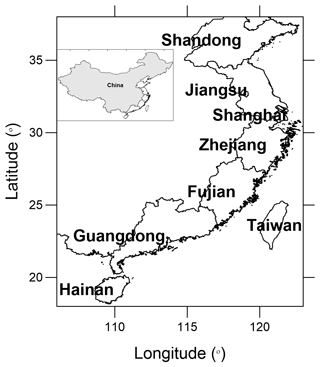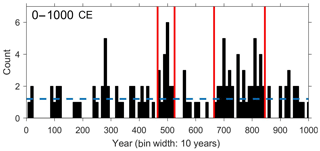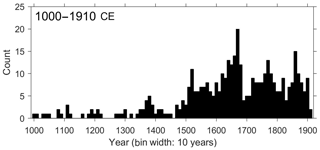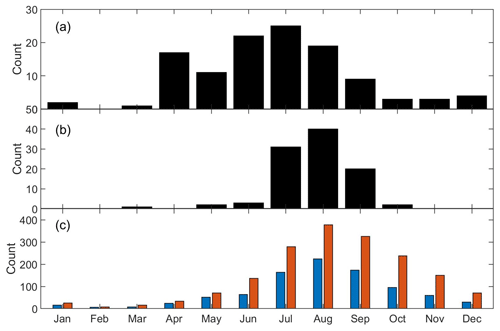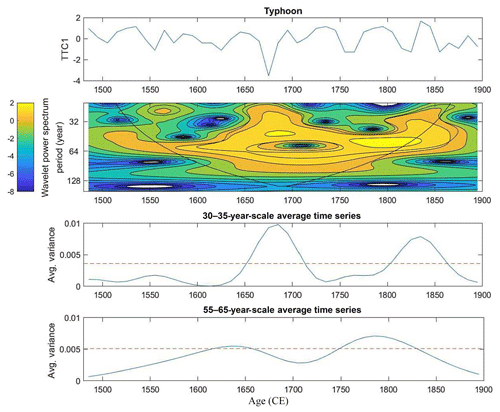the Creative Commons Attribution 4.0 License.
the Creative Commons Attribution 4.0 License.
China's historical record when searching for tropical cyclones corresponding to Intertropical Convergence Zone (ITCZ) shifts over the past 2 kyr
Yen-Chu Liu
Chih-Wen Chiang
Xingqi Liu
Yu-Min Chou
Hui-Juan Pan
The northwestern Pacific Ocean and South China Sea are where tropical cyclones occur most frequently. Many climatologists also study the formation of Pacific Ocean warm pools and typhoons in this region. This study collected data of paleotyphoons found in China's official historical records over the past 2000 years that contained known typhoon activity reports. The collected data are then subjected to statistical analyses focusing on typhoon activity in coastal regions of southeastern China to garner a better understanding of the long-term evolution of moving paths and occurrence frequency, especially regarding those typhoons making landfall in mainland China. We analyzed the data with the year and month of each typhoon event, as well as the number of events in a 10-year period. The result shows that (1) north–southward migration of typhoon paths corresponds to the north–southward migration of the Intertropical Convergence Zone (ITCZ) during the Medieval Warm Period (MWP) and Little Ice Age (LIA) and (2) paleotyphoons made landfall in mainland China 1 month earlier during the MWP than during the LIA. This implies a northward shift in ITCZ during the MWP. Typhoons tend to make landfall in Japan during El Niño-like periods and strike the southern coastal regions of China during La Niña-like stages. According to paleotyphoon records over the last 2000 years, typhoons made landfall in southeastern China frequently around 490–510, 700–850, and after 1500 CE The number of typhoons striking Guangdong Province peaked during the coldest period in 1660–1680 CE; however, after 1700 CE, landfall has migrated farther north. The track of tropical cyclones (TCs) in the northwestern Pacific Ocean is affected by the North Atlantic Oscillation (NAO) and the Pacific Decadal Oscillation (PDO), which shows a nearly 30-year and a 60-year cycle during the LIA.
- Article
(3782 KB) - Full-text XML
-
Supplement
(144 KB) - BibTeX
- EndNote
Tropical cyclones (TCs) are a serious hazard. According to the Federal Emergency Management Agency (FEMA) of the USA, the total amount of money spent on flood recovery programs due to TC activity was greater than that spent on any other natural catastrophe during the period 2005 to 2015. The level of destruction caused by TCs has meant they have been the focus of a great deal of current research as well as being part of the historical record of China for millennia. Among all tropical cyclones, 37 % occur in the northwestern Pacific Ocean (Liang and Ye, 1993). These TCs are of a greater intensity and make landfall more frequently in this region than those making landfall in the western Atlantic Ocean. People pay a great deal of attention to the frequency and tracks of TCs on Earth. The path of TCs in the Pacific Ocean is driven by the clockwise rotation of the subtropical North Pacific High, and it takes three paths away from this genesis region: (1) a westerly path straight toward south China; (2) a west–northwesterly path curving back to Japan; and (3) a north-oriented path that keeps them out at sea (Elsner and Liu, 2003). Most existing TC records are based on short-term research that covers the past few decades (Wu and Lau, 1992; Lander, 1994). Short-term weather records indicate that TC paths may be directly influenced by variations in the El Niño Southern Oscillation (ENSO) in the equatorial Pacific region (Chan, 1985; Lander, 1994; Wang and Chan, 2002; Elsner and Liu, 2003; Ho et al., 2004; Chu, 2004), and ENSO is highly related to the Pacific Decadal Oscillation (PDO; Pavia et al., 2006; Feng et al., 2013). Another dynamic forcing influence on the pathways of TCs is related to the Intertropical Convergence Zone (ITCZ) position and North Atlantic Oscillation (NAO) (Gil et al., 2006).
However, climate study literature is severely lacking longer-term studies with more data that cover hundreds of years. For the purpose of tracking TC pathways in the long term, we need geological records from natural sediment from lake cores and lagoons originating in a widespread coastal area. The geological records indicate that ancient TC activity were enhanced by ENSO activity after the middle Holocene, both in the Atlantic and Pacific oceans (Donnelly and Woodruff, 2007; Woodruff et al., 2009; Chen et al., 2012; McCloskey and Liu, 2012, 2013; McCloskey et al., 2013; Liu et al., 2015). Therefore, we attempted to collect more TC data from these documents and understand some of the fragmented historical records. Bossak et al. (2014) discussed the statistical records of regional TC occurrence since 1851 from the southeastern Atlantic coastal region of the United States of America. In addition, the historical record of TC occurrence in the northwestern Pacific has a longer historical record in China. Chan and Shi (2000) first published the frequency of typhoon landfall over Guangdong Province of China during the period of 1470–1931 CE, and then Liu et al. (2001) examined historical records dating back to 1000 years ago in Guangdong Province. Further research also tried to integrate statistical records of TC occurrence in southeastern coastal China over the last 400 years (Fogarty, 2004).
In this study, we attempted to collate statistics on the landfall frequency of TCs recorded in China's written historical record with typhoon intensity recorded in the geological record of lake sediments in northeastern Taiwan to investigate TC path migration in the northwestern Pacific Ocean region over the last 2 kyr.
China's historical record is a rich source of documented evidence on climatic
conditions dating back millennia. Abnormalities in climatic
conditions found in China's records have been successfully applied in the
reconstruction of regional climate changes (Liu et al., 2001; Chu et al.,
2002, 2008). Previous research revealed that the term jufeng (cyclone, ![]() ) first appeared
in the Southern and Northern dynasties around 420–479 CE (Liu et al., 2001). During the
following Tang Dynasty (618–907 CE) many climate phenomena relating to
torrential rainfall and strong winds resembling typhoons were recorded in
poems (Louie and Liu, 2003). Since the Northern Song Dynasty (960–1126 CE),
Chinese governmental institutions have kept a continuous record of typhoon
strikes reported by local administrative authorities (Louie and Liu, 2003;
Liu et al., 2001). The term “typhoon”
(
) first appeared
in the Southern and Northern dynasties around 420–479 CE (Liu et al., 2001). During the
following Tang Dynasty (618–907 CE) many climate phenomena relating to
torrential rainfall and strong winds resembling typhoons were recorded in
poems (Louie and Liu, 2003). Since the Northern Song Dynasty (960–1126 CE),
Chinese governmental institutions have kept a continuous record of typhoon
strikes reported by local administrative authorities (Louie and Liu, 2003;
Liu et al., 2001). The term “typhoon”
(![]() ) first appeared during
the Qing Dynasty with documented evidence of typhoon landfall on Taiwan first
appearing in 1750 CE.
) first appeared during
the Qing Dynasty with documented evidence of typhoon landfall on Taiwan first
appearing in 1750 CE.
China's written historical record dates back 3000 years. The statistical records used in our study include data from southeastern coastal China and Taiwan (Fig. 1). The data source upon which our study is based is a book entitled A syllogism of China's meteorological record over the past 3000 years (Zhang, 2013). This book consists of 7813 pieces of documentary evidence from China's historical documents, including 7713 pieces from local government bodies and another 28 from other historical documents. In total, there are more than 220 000 recorded events.
After thorough verification of data sources, the timing and event locations found in the record primary source reports were kept and duplicates eliminated. Zhang (2013) is, by far, the most complete and commonly accepted climate record from China's documented history.
Considering the evolution of typhoon-related keywords over the years, in
addition to using the specific keywords typhoon and jufeng to search for records
since 1000 CE, related expressions such as “strong wind”
(![]() ), “rainstorm”
(
), “rainstorm”
(![]() ) and “storm surge”
(
) and “storm surge”
(![]() ) were also applied to our
search. However, the terms jufeng and typhoon rarely appeared in the
historical record prior to 1000 BP. So, for this earlier period, we added
additional terms that are possibly associated with typhoon such as
“trunk pulling” (
) were also applied to our
search. However, the terms jufeng and typhoon rarely appeared in the
historical record prior to 1000 BP. So, for this earlier period, we added
additional terms that are possibly associated with typhoon such as
“trunk pulling” (![]() ),
“tree pulling” (
),
“tree pulling” (![]() ),
“collapsed building” (
),
“collapsed building” (![]() ) and “wind storm” (
) and “wind storm” (![]() ) to
our statistical study. We attempt to reconstruct the time of occurrence and
the location of paleotyphoons along the coastal region in China and to
understand the evolution of typhoon development over a long period of time.
It is worth noting that every episode would be recorded in historical
documents due to significant damage or a disaster. As a result, we
speculate that the strengths of typhoons would be above moderate. All ancient
Chinese literatures was listed in the appendix of Liu (2015). Table 1 shows
some of the original historical sources based on Zhang (2013).
) to
our statistical study. We attempt to reconstruct the time of occurrence and
the location of paleotyphoons along the coastal region in China and to
understand the evolution of typhoon development over a long period of time.
It is worth noting that every episode would be recorded in historical
documents due to significant damage or a disaster. As a result, we
speculate that the strengths of typhoons would be above moderate. All ancient
Chinese literatures was listed in the appendix of Liu (2015). Table 1 shows
some of the original historical sources based on Zhang (2013).
4.1 Statistical results on the frequency of typhoon landfall
The statistical data collected for the southeastern coastal regions of China include data for Hainan, Guangdong, Fujian, Taiwan, Zhejiang, Shanghai, Jiangsu and Shandong (Fig. 1). When we categorized typhoon landfall locations based on latitudes, Fujian and Taiwan are recognized as one region due to their similarities in latitude and the same applies to Jiangsu and Shanghai. It is notable that prior to 0 CE the historical record of China lacks data on typhoon activity. Consequently, this study focuses on data collected over the last 2 kyr. Furthermore, data for the period 1945–2013 CE were collected from the northwestern Pacific Ocean TC records established by the Joint Typhoon Warning Center (JTWC). The statistical results were divided into three different time frames based on keyword results and database sources: (1) 0–1000 CE; (2) 1000–1910 CE; and (3) 1945–2013 CE. To plot the number of typhoons occurring as a function of time, typhoon events in any given decade were collectively plotted to create an interdecadal bar graph dating from 1000 CE to the present (Fig. 2). The number of events which occurred in any given decade relates closely to the age of historical documents and how well they have been preserved. Records relating to TC landfall between 1945 and 2013 CE are reliant on satellite-acquired data, meaning the data source is highly reliable in terms of its location and intensity. Consequently, Fig. 2 shows extreme growth in the number of recorded TCs in the latter years of the twentieth century. Moreover, Liu et al. (2017) published TC landfall data for the northwestern Pacific Ocean region between 1945 and 2013 CE, which corresponds to the results seen here. The Fig. 2 shows clearly that TC activity grew to an extraordinary extent at around 1500 CE and has persisted to the present.
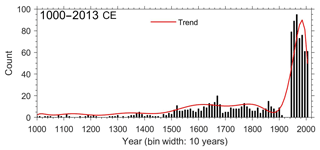
Figure 2Historical paleotyphoon data compiled over the past 1000 years from China's historical record and JTWC data for southeastern China and Taiwan. Each bar in the bar graph represents the collective number of typhoons occurring in any given decade.
4.1.1 Statistical typhoons between 0 and 1000 CE
The term jufeng did not appear in any historical documents before 1000 CE. Some of the documents, however, only mentioned disaster conditions such as trunk pulling, tree pulling, collapsed building, wind storm and “torrential rain”. Given these limitations, all the typhoon records from 0 to 1000 CE were examined for using these assemblage proxies. The original results are listed in Table S1 of the Supplement. There were 124 possible typhoon events found in the records, which are presented in Fig. 3. The figure shows that, for the time period 0–1000 CE, on average 1.2 typhoons were recorded every 10 years. Based on this result, we define the periods that average more than 1.2 typhoons every 10 years, which were recorded continuously for 50 years, as a high-frequency typhoon period. Figure 3 shows that the periods 490–510 CE (Southern and Northern dynasties) and 700–850 CE (Tang Dynasty) were periods of frequent TC invasions. Our statistical results correspond to the fact that many instances of storm damage are mentioned in ancient poetry from the Tang Dynasty (Louie and Liu, 2003).
4.1.2 Statistical typhoons between 1000 and 1910 CE
Figure 4 gives a total of 408 events relating to the terms jufeng and typhoon for the period 1000–1910 CE. Original data are listed in Table S2 of the Supplement. Starting from 1460 CE, the number of TC landfalls suddenly starts to increase peaking between 1670 and 1679 CE. Other periods with substantial numbers of TCs making landfall are 1520–1529, 1770–1779, and 1860–1869 CE. During these times, recorded typhoon landfall was greatest in the Guangdong region (Fig. 6).
To make sure the historical record accurately reflected climatic conditions for the period examined, a search of the record was conducted for anomalous climatic events such as flooding, snow storms, droughts and so on. It was found that there were extensive gaps in the data for the periods 1270–1320 and 1400–1450 CE, which are the two periods that corresponded to the advent of the Yuan and Ming dynasties, respectively. All original data sources are listed in Table S5 of the Supplement. The Yuan Dynasty was established by the foreign-led dynasty of Kublai Khan of Mongolia. It was a period characterized by much internal strife and rebellion. The lack of good climate data in the historical record for the period 1400–1450 CE at first glance might seem surprising as it is the time of the Yongle Emperor and the promotion of Admiral Zhenghe, the eunuch commander of the seven great international tributary voyages across the South China Sea and Indian Ocean (1405–1430 CE). It would seem likely that weather conditions, especially TC would be of great importance to China, and this information would have been carefully recorded. This period is well described in the book 1421: the year China discovered America (Menzies, 2008). In fact it is thought Zhenghe did record such detail, but much of it was lost or burned during eunuch and internal conflicts at the time of Emperor Yongle. The historical records were terminated in CE 1911 because the Qing Dynasty was overthrown and a civil war was fought in China for a long period of time. In addition, World War I occurred between 1914 and 1918 CE, and World War II took place from 1939 to 1945 CE. Therefore, China lacks climate records in the turmoil of war during this period in history.
4.2 The change in months of the year when typhoons occur
To further investigate any changes in the timing of annual TC landfall, TC landfall data were collected and analyzed for three different time periods: 0–1000 CE; 1000–1910 CE; and 1945–2013. The results are shown in Fig. 5, and monthly statistics are listed in Table S3 of the Supplement. Before 1000 CE, TCs in China mostly occurred in June, July and August (Fig. 5a). However, after 1000 CE, the entire trend in arrival times shifted by 1 month, with TC landfall occurring predominantly in July, August and September (Fig. 5b). The majority of statistics after 1000 CE were collected during the Little Ice Age (LIA; 1400–1850 CE). Figure 5c shows statistics for the period 1945–2013 CE The timing of recent TCs making landfall in southeastern China is quite similar to that which occurred during the LIA period. Recent data show that TC occurrence in the entire northwestern Pacific Ocean region can last until as late as October, November and December with TCs making landfall in Vietnam, the Philippines and Thailand after September (Liu et al., 2017). It is assumed that this relates to seasonal changes in the positions of the subtropical high and ITCZ of the northwestern Pacific Ocean region. The ITCZ begins migrating north away from the Equator in March or April. It reaches its northernmost position in August, before migrating south in September (Waliser and Gautier, 1993). The question this study raises is what occurrence shifted the predominant timing of TC arrival in southeastern China from between June and August between 0 and 1000 CE to between July and September after 1000 CE. One likely explanation is that the ITCZ was at a higher latitude before 1000 CE (Rehfeld et al., 2013), resulting in earlier (June–August) TC formation.
4.3 The spatial distribution of the typhoons – the relationship between landfall locations and occurrence frequencies
Not all historical records gave details on where TCs struck before 1000 CE; therefore, this study focuses solely on the landfall locations of paleotyphoons between 1000 and 1910 CE. The number of typhoons that struck each province in China is shown in Fig. 6. Table S4 of the Supplement gives additional details on landfall locations. For the period 1000–1910 CE, Guangdong was struck by the most TCs. On the whole, the number of TCs making landfall increased dramatically after 1500 CE, with the number of typhoons hitting Guangdong peaking between 1660 and 1680 CE. By contrast, regions north of Fujian did not record any increase in typhoon activity during this time period. The number of typhoons striking Zhejiang and Jiangsu, however, did start to increase after 1700 CE.
Newton et al. (2006) proved that the warmest temperatures in the Indo-Pacific Warm Pool occurred during the Medieval Warm Period while the coolest temperatures occurred during the Little Ice Age. In particular, the lowest temperatures occurred around 1660–1680 CE within the period of the Maunder Minimum (1645–1715 CE). Therefore, it is thought that the sudden change in TC tracks around 1700 CE may relate to a change in temperature lows in the Northern Hemisphere and a shift in the location of the ITCZ.

Figure 6The number of typhoons that struck the southeastern regions of China and Taiwan between 1000 and 1910 CE. (Red line means the time boundary of 1700 CE. More TCs made landfall in Guandong before this time, but more TCs made landfall to northward after this time.)
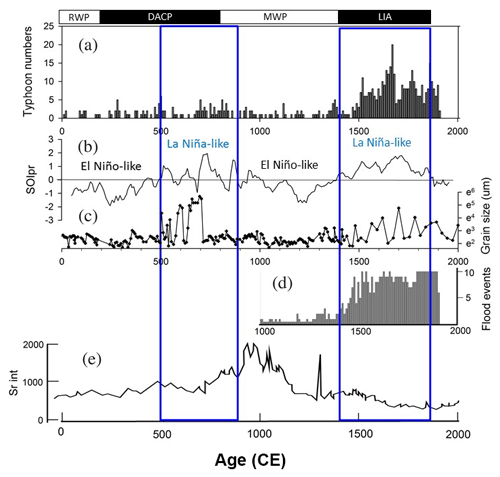
Figure 7Correlations between typhoon events and ENSO. (a) Number of typhoons recorded in Chinese historical documents for the last 2000 years. (b) SOIpr (Southern Oscillation Index from precipitation proxies; Yan et al., 2011). (c) The change in particle sizes from lake sediments from Yilan, Taiwan, indicating the change in magnitude of typhoon rainfall (Chen et al., 2012). (d) Number of flooding events recorded in Chinese historical documents (Chu et al., 2002). (e) Variation in Sr in lagoon sediments from Kyushu, Japan, indicating influences from exceptionally strong typhoons (Woodruff et al., 2009). RWP: Roman Warm Period; DACP: Dark Ages Cold Period.
5.1 Northwestern Pacific Ocean paleotyphoon track changes during the MWP and LIA
Conserving historical documents has always been a difficult task. Racial conflicts, war, rebellion and inter-court feuds could all result in precious data being damaged, destroyed or lost during certain periods in history. Consequently, statistics on paleotyphoons recorded in the historical record are only semiquantitative. On the other hand, they are very useful in terms of noting the location of landfalls and the precise timing of such events. To help overcome any anomalies in the typhoon record lost to documented history and to avoid any confusion regarding the intensity of events, this study also looked at the geological record of paleotyphoons derived from lake sediments in northeastern Taiwan (Chen et al., 2012; Yang et al., 2014; Wang et al., 2013, 2014, 2015). Since the topography of northeastern Taiwan's Yilan region is quite unique, with the summer monsoon being blocked by mountains and rainfall being mainly supplied by the winter monsoon and typhoons (Chen et al., 2012), the region is very helpful for studying TC in the northwestern Pacific. In fact, large-scale river terraces have occurred due to typhoon rainfall, and this record has been preserved in the mountain areas of Yilan since 2.7 ka (Hsieh, 2017).
In order to correlate the number of paleotyphoons from historical data with the geological record of lake sediments, the Southern Oscillation Index (SOI), the intensity of paleotyphoons determined from sedimentary particle size at Taiwan's Lake Dahu and paleotyphoon signals from lagoon sediments in Kyushu, Japan (Fig. 7), are referenced and compared. Results suggest that typhoons struck Taiwan and the southeastern coastal region of China mostly during La Niña-like stages (Fig. 7a, b, c) (Chen et al., 2012). This outcome matches that mentioned by historical maritime disaster events caused by paleotyphoons in the last 1000 years in Liu et al. (2017). According to Liang and Zhang (2007), the chances of a typhoon making landfall in the southeastern coastal region of China during La Niña years is higher than that during El Niño years. If we started entering an El Niño-like stage after 1900 CE, this means the number of typhoons striking Japan in the future will very likely increase compared to what we see now. This trend in the data since 1700 CE shows a gradual increase in typhoon numbers moving north and away from Guangdong (Fig. 6). It has also been shown that the number and intensity of typhoons recorded in Taiwan's lake sediments has grown since the LIA (1400 CE) which seems to match the general trend in the recorded number of historical events pretty well (Fig. 7a and c). This period also coincided with the timing of flooding events in southern China (Fig. 7d). Park et al. (2017) investigated the records of lake sediments in the East Asia region. Their study noted that along coastal regions including Jeju Island (Korea), lakes in Yilan (Taiwan), Lake Huguangyan in Guangdong, and lakes on Hainan Island relatively drier conditions prevailed during the MWP and wetter conditions during the LIA. This may be due to an increase in rainfall caused by typhoons along the coast.
This study, therefore, finds that the northward migration of the ITCZ during the MWP caused typhoons to move north toward Japan. In contrast, typhoons moved toward southern China during the LIA due to the southward transition of the ITCZ. This seems to be a reasonable explanation and is not out of step with other regional studies (Rehfeld et al., 2013; Chen et al., 2015; Xu et al., 2016).
5.2 The linkage between ancient TCs of the northern Atlantic Ocean and northern Pacific Ocean
Donnelly and Woodruff (2007) first suggested that the number of hurricanes in the Caribbean area has been increasing over the last 4000 years. According to ancient hurricane research along the Gulf Cost and Caribbean Sea to Puerto Rico, hurricane tracks show an antiphase in time series data (McCloskey and Liu, 2012, 2013; McCloskey et al., 2013; Liu et al., 2015). During the MWP, more TCs made landfall in the Gulf Coast as the strength of the Bermuda High enhanced and the ITCZ moved northward. During the LIA, more TCs made landfall in the Caribbean Sea (McCloskey and Knowles, 2009; McCloskey and Liu, 2012, 2013; McCloskey et al., 2013). In 1650 CE, TC frequency reached a peak, and after 1850 CE TCs began to move toward Florida and Bermuda with the northward movement of the ITCZ (Baldini et al., 2016). Ancient lake sediment data from Yilan, Taiwan, reveals the period in history when paleotyphoons occurred most frequently. This timing correlates highly with the time of paleohurricanes recorded in Belize from McCloskey and Liu (2013). This suggests that the migration paths of TCs in both the northwestern Pacific Ocean region and the northwestern Atlantic Ocean region are closely related. TC activity occurred between 200 and 600 and between 1450 and 2600 yr BP in Belize, and it occurred between 200 and 500, 1300 and 1500, and 2000 and 2300 yr BP in Taiwan's lakes (Chen et al., 2012). This phenomenon indicates a close association between TC activity in the North Pacific Ocean and the North Atlantic Ocean.
5.3 The tracks of TCs corresponding to the NAO during the LIA
Since the ITCZ and westerlies are both linked to the Hadley Cell, and the position of midlatitude storms are determined by the westerlies, which are influenced by the North Atlantic Oscillation (NAO) (Hurrell, 1995; Morley et al., 2014), we compared the NAO record with the track of TCs. In order to compare our tracks of TCs with the NAO, we created an index called TTC1 to represent the track of TCs that either move toward southern China or toward northern China (TTC1 ). Xi is the number of typhoons that had made landfall in a particular province, and Fi means the location factor of the landfall locality (Table 2). When the value of TTC1 is higher, it indicates a larger amount of typhoon landfalls in northern China (Fig. 8). The TTC1 can also be normalized to values between 0 and 1. Furthermore, we used digitalization to retrieve the average data of 10 years from the 2 kyr NAO index according to the results of Trouet et al. (2009) and Ortega et al. (2015). The results calculated from Trouet et al. (2009) and our TTC1 agree quite well (Fig. 8). However, our records were fragmentary before 1470 CE, and we lack the historical data from Japan. The results in Fig. 8 reveal that our normalized TTC1 corresponding to the NAOTrouet during the LIA stage, and the 3-point smoothing of the TTC1 shows a very good correlation with the NAOTrouet. This result indicates that the NAO influences the migration of the westerlies, and it may also gently affect the tracks of the TCs.
After we performed the wavelet analysis, we found that the TTC1 shows both 30–35- and 55–65-year cycles during the LIA stage (Fig. 9). This result is also consistent with the frequency of typhoon landfall over Guangdong Province of China during the period of 1470–1931 CE based on a different data source (Chan and Shi, 2000). The 60-year cycle is clearly present in the PDO and the Atlantic Multi-decadal Oscillation (AMO), with phases coherent with a planetary signal since at least 1650 to 1850 CE (Scafeta, 2012; Solheim, 2013). This implies that the PDO also affects the TTC1 cycle.
We statistically analyzed Chinese historical documents to understand the relationship between the MWP, LIA and movements in the ITCZ. Our conclusions are very similar to those found in previous studies, indicating that China's documented historical record is an invaluable asset in the study of climatological phenomena. The conclusions are as follows:
-
Before 1000 CE, TCs struck China mostly in June, July and August. The timing of TC landfall shifted to July, August and September after 1000 CE.
-
Statistical analyses of China's historical documents show that there was a sudden increase in the frequency of paleotyphoons in 490–510, 700–850 CE and since the beginning of the LIA (1400 CE).
-
Correlating lake core records from Taiwan and Japan proved that more typhoons made landfall in Guangdong and Taiwan during the LIA, whereas, more typhoons made landfall in Japan during the MWP.
-
Most typhoons made landfall in Guangdong in the coldest period of the LIA. Typhoon tracks started migrating towards Fujian and farther north after 1700 CE, indicating that there is a northward trend in typhoons towards Japan.
-
The track of TCs has 30–35- and 55–65-year cycles during the LIA stage; the result is consistent with the variation in the NAO and the PDO cycles.
Paleoclimate research covering the last 2000 years since the late Holocene mainly focuses on three drastic temperature fluctuation periods, i.e., the MWP, LIA and the global warming of the past 200 years. Our study shows that the paths of paleotyphoons between the MWP and LIA are closely related to the migration of the ITCZ. The results also demonstrate that the migration paths of TCs in the northern Pacific Ocean and the northern Atlantic Ocean are highly correlated with the NAO and the PDO cycles.
We show all data in the Supplement.
The supplement related to this article is available online at: https://doi.org/10.5194/cp-15-279-2019-supplement.
HFC coordinated and wrote this paper; HFC conceived the present idea and explained the conclusions; YCL read all records and obtained statistical results; XL and YMC contributed original books and helped collect data; CWC and HJP drew some of the figures and did the wavelength analysis.
The authors declare that they have no conflict of interest.
This study was supported by the National Taiwan Ocean University and grants
NSC103-2116-M-019-003 and NSC106-2116-M-019-004 from the National Science
Council of Taiwan. We are grateful for Kam-Biu Liu at Louisiana State
University, who started the research of paleotyphoons by using historical
records. His research was greatly edifying.
Edited by: Chantal Camenisch
Reviewed by: James Elsner, David
Nash, and one anonymous referee
Baldini, L. M., Baldini, J. U. L., McElwaine, J. N., Frappier, A. B., Asmerom, Y., Liu, K. B., Prufer, K. M., Ridley, H. E., Polyak, V., Kennett, D. J., Macpherson, C. G., Aquino, V. V., Awe, J., and Breitenbach, S. F. M.: Persistent northward North Atlantic tropical cyclone track migration over the past five centuries, Sci. Rep.-UK, 6, 37522, https://doi.org/10.1038/srep37522, 2016.
Bossak, B. H., Keihany, S. S., Welford, M. R., and Gibney, E. J.: Coastal Georgia is not immune: hurricane history, 1851–2012, Southeastern Geographer, 54, 323–333, https://doi.org/10.1353/sgo.2014.0027, 2014.
Chan, J. C. L.: Tropical cyclone activity in the northwest Pacific in relation to the El Niño/Southern Oscillation phenomenon, Mon. Weather Rev., 113, 599–606, 1985.
Chan, J. C. L. and Shi, J. E.: Frequency of typhoon landfall over Guangdong Province of China during the period 1470–1931, Int. J. Climatol., 20, 183–190, 2000.
Chen, H. F., Wen, S. Y, Song, S. R., Yang, T. N., Lee, T. Q., Lin, S. F., Hsu, S. C., Wei, K. Y., Chang, P. Y., and Yu, P. S.: Strengthening of paleo-typhoon and autumn rainfall in Taiwan corresponding to the Southern Oscillation at Late Holocene, J. Quaternary Sci., 27, 964–972, 2012.
Chen, J., Chen, F., Feng, S., Huang, W., Liu, J., and Zhou, A.: Hydroclimatic changes in China and surroundings during the Medieval Climate Anomaly and Little Ice Age: spatial patterns and possible mechanisms, Quaternary Sci. Rev., 107, 98–111, 2015.
Chu, G., Liu, J., Sun, Q., Lu, H., Gu, Z., Wang, W., and Liu, T.: The mediaeval warm period drought recorded in Lake Huguangyan, tropical South China, The Holocene, 12, 511–516, 2002.
Chu, G., Sun, Q., Wang, X., and Sun, J.: Snow anomaly events from historical documents in eastern China during the past two millennia and implication for low-frequency variability of AO/NAO and PDO, Geophys. Res. Lett., 35, L14806, https://doi.org/10.1029/2008GL034475, 2008.
Chu, P. S.: ENSO and tropical cyclone activity. Hurricanes and Typhoons: Past, Present, and Potential, edited by: Murnane, R. J. and Liu, K. B., Columbia University Press, 279–332, 2004.
Donnelly, J. P. and Woodruff, J. D.: Intense hurricane activity over the past 5000 years controlled by El Nino and the West African monsoon, Nature, 447, 465–468, 2007.
Elsner, J. B. and Liu, K. B.: Examining the ENSO–typhoon hypothesis, Clim. Res., 25, 43–54, 2003.
Feng, J., Wang, L., and Chen, W.: How does the east Asian summer monsoon behave in the decaying phase of El Ninõ during different PDO phases?, J. Climate, 27, 2682–2698, 2013.
Forgaty, E. A.: Variations in typhoon landfall over China, Master thesis, The Florida State University, College of Social Scinces, 35 pp., 2004.
Gil, I. M., Abrantes, F., and Hebbeln, D.: The North Atlantic Oscillation forcing through the last 2000 years: Spatial variability as revealed by high-resolution marine diatom records from N and SW Europe, Mar. Micropaleontol., 60, 113–129, 2006.
Ho, C. H., Baik, J. J., Kim, J. H., Gong, D. Y., and Sui, C. H.: Interdecadal changes in summertime typhoon tracks, J. Climate, 17, 1767–1776, 2004.
Hsieh, M. L.: Holocene mass-wasting records in northern Taiwan and their implication on prehistorical typhoon track, 2nd International Conference on Quaternary and Future Earth: Harmonious Coexistence of Ocean and Humans, p. 13, 2017.
Hurrell, J. W.: Decadal trends in the North Atlantic Oscillation: regional temperatures and precipitation, Science, 269, 676–679, 1995.
Lander, M.: An exploratory analysis of the relationship between tropical storm formation in the western North Pacific and ENSO, Mon. Weather Rev., 122, 636–651, 1994.
Liang, B. Q. and Ye, J. C.: The natural disaster of Guangdong Province, Guangdong People's Press, 1993 (in Chinese).
Liang, Y. and Zhang, D.: Landing typhoon in China during the last millennium and its relationship with ENSO, Advances in Climate Change Research, 3, 120–121, 2007 (in Chinese).
Liu, K. B., Shen, C., and Louie, K. S.: A 1,000 Year History of Typhoon Landfalls in Guangdong, Southern China, Reconstructed from Chinese Historical Documentary Records, Ann. Assoc. Am. Geogr., 91, 453–464, 2001.
Liu, K.-B., McCloskey, T. A., Ortego, S., and Maiti, K.: Sedimentary signature of Hurricane Isaac in a Taxodium swamp on the western margin of Lake Pontchartrain, Louisiana, USA, Proc. IAHS, 367, 421–428, https://doi.org/10.5194/piahs-367-421-2015, 2015.
Liu, Y. C.: The study in the frequency of paleo-typhoon hazards and invasion locations since 2000 years ago in China, Master thesis of National Taiwan Ocean University, Keelung, 141 pp., 2015 (in Chinese).
Liu, Y. C., Chen, H. F., Liu, X., and Chang, Y. P.: Insight into Tropical Cyclone Behaviour through Examining Maritime Disasters over the Past 1000 Years Based on the Dynastic Histories of China – A Dedication to Ocean Researcher V., Quatern. Int., 440, 72–81, 2017.
Louie, K. S. and Liu, K. B.: Earliest historical records of typhoons in China, J. Hist. Geogr., 29, 299–316, 2003.
McCloskey, T. A. and Knowles, J. T.: Migration of the Tropical Cyclone Zone throughout the Holocene, in: Hurricanes and Climate Change, edited by: Elsner, J. B. and Jagger, T. H., Springer, New York, 169–188, 2009.
McCloskey, T. A. and Liu, K. B.: A Sedimentary-Based History of Hurricane Strikes on the Southern Caribbean Coast of Nicaragua, Quaternary Res., 78, 454–464, 2012.
McCloskey, T. A. and Liu, K. B.: A 7000-Year Record of Paleohurricane Activity from a Coastal Wetland in Belize, The Holocene, 23, 276–289, 2013.
McCloskey, T. A., Bianchette, T. A., and Liu, K. B.: Track Patterns of Landfalling and Coastal Tropical Cyclones in the Atlantic Basin, Their Relationship with the North Atlantic Oscillation (NAO), and the Potential Effect of Global Warming, American Journal of Climate Change, 2, 12–22, 2013.
Menzies, G.: 1421: The Year China Discovered America, HarperCollins Publishers Inc., New York, 657 pp., 2008.
Morley, A., Rosenthal, Y., and DeMenocal, P.: Ocean-atmosphere climate shift during the mid-to-late Holocene transition, Earth Planet. Sc. Lett., 388, 18–26, 2014.
Newton, A., Thunell, R., and Stott, L.: Climate and hydrographic variability in the Indo-Pacific Warm Pool during the last millennium, Geophys. Res. Lett., 33, L19710, https://doi.org/10.1029/2006GL027234, 2006.
Ortega, P., Lehner, F., Swingedouw, D., Masson-Delmotte, V., Raible, C. C., Casado, M., and Yiou, P.: A model-tested North Atlantic Oscillation reconstruction for the past millennium, Nature, 523, 71–74, 2015.
Park, J., Han, J., Jin, Q., Bahk, J., and Yi, S.: The Link between ENSO-like Forcing and Hydroclimate Variability of Coastal East Asia during the Last Millennium, Sci. Rep.-UK, 7, 8166, https://doi.org/10.1038/s41598-017-08538-1, 2017.
Pavia, E. G., Graef, F., and Reyes, J.: Notes and correspondence PDO–ENSO effects in the climate of Mexico, J. Climate, 19, 6433–6438, 2006.
Rehfeld, K., Marwan, N., Breitenbach, S. F. M., and Kurths, J.: Late Holocene Asian summer monsoon dynamics from small but complex networks of paleoclimate data, Clim. Dynam., 41, 3–19, 2013.
Scafetta, N.: A shared frequency set between the historical midlatitude aurora records and the global surface temperature, J. Atmos. Sol.-Terr. Phy., 74, 45–163, 2012.
Solheim, J.-E.: Signals from the planets, via the Sun to the Earth, Pattern Recogn. Phys., 1, 177–184, https://doi.org/10.5194/prp-1-177-2013, 2013.
Trouet, V., Esper, J., Graham, N. E., Baker, A., Scourse, J. D., and Frank, D. C.: Persistent positive North Atlantic Oscillation mode dominated the medieval climate anomaly, Science, 324, 78–80, 2009.
Waliser, D. E. and Gautier, C.: A satellite-derived climatology of the ITCZ, J. Climate, 6, 2162–2174, 1993.
Wang, B. and Chan, J. C. L.: How strong ENSO events affect tropical storm activity over the western North Pacific, J. Climate, 15, 1643–1658, 2002.
Wang, L. C., Behling, H., Lee, T. Q., Li, H. C., Huh, C. A., Shiau, L. J., Chen, S. H., and Wu, J. T.: Increased precipitation during the Little Ice Age in northern Taiwan inferred from diatoms and geochemistry in a sediment core from a subalpine lake, J. Paleolimnol., 49, 619–631, 2013.
Wang, L.-C., Behling, H., Lee, T.-Q., Li, H.-C., Huh, C.-A., Shiau, L.-J., and Chang, Y.-P.: Late Holocene environmental reconstructions and their implications on flood events, typhoon, and agricultural activities in NE Taiwan, Clim. Past, 10, 1857–1869, https://doi.org/10.5194/cp-10-1857-2014, 2014.
Wang, L. C., Behling, H., Kao, S. J., Li, H. C., Selvaraj, K., Hsieh, M. L., and Chang, Y. P.: Late Holocene environment of subalpine northeastern Taiwan from pollen and diatom analysis of lake sediments, J. Asian Earth Sci., 114, 447–456, 2015.
Woodruff, J. D., Donnelly, J. P., and Okusu, A.: Exploring typhoon variability over the mid-to-late Holocene: evidence of extreme coastal flooding from Kamikoshiki, Japan, Quaternary Sci. Rev., 28, 1774–1785, 2009.
Wu, G. and Lau, N. C.: A GCM simulation of the relationship between tropical storm formation and ENSO, Mon. Weather Rev., 120, 958–977, 1992.
Xu, H., Lan, J., Sheng, E., Liu, B., Yu, K., Ye, Y., Shi, Y., Cheng, P., Wang, X., Zhou, X., and Yeager, K. M.: Hydroclimatic contrasts over Asian monsoon areas and linkages to tropical Pacific SSTs, Sci. Rep.-UK, 6, 33177, https://doi.org/10.1038/srep33177, 2016.
Yan, H., Sun, L., Wang, Y., Huang, W., Qiu, S., and Yang, C.: A record of the Southern Oscillation Index for the past 2,000 years from precipitation proxies, Nat. Geosci., 4, 611–614, 2011.
Yang, T. N., Lee, T. Q., Lee, M. T., Huh, C. A., Meyers, P. A., Löwemark, L., Wang, L. C., Kao, W. Y., Wei, K. Y., Chen, R. F., Chen, H. F., Chen, S. H., Wu, J. T., Shiau, L. J., Chen, Y. G., and Hsieh, Y. C.: Paleohydrological changes in northeastern Taiwan over the past 2 ky inferred from biological proxies in the sediment record of a floodplain lake, Palaeogeogr. Palaeocl., 410, 401–411, https://doi.org/10.1016/j.palaeo.2014.06.018, 2014.
Zhang, D.: A Syllogism of China's “Meteorological Record over the past 3000 Years”, Jiangsu Education Press, 2013 (in Chinese).






